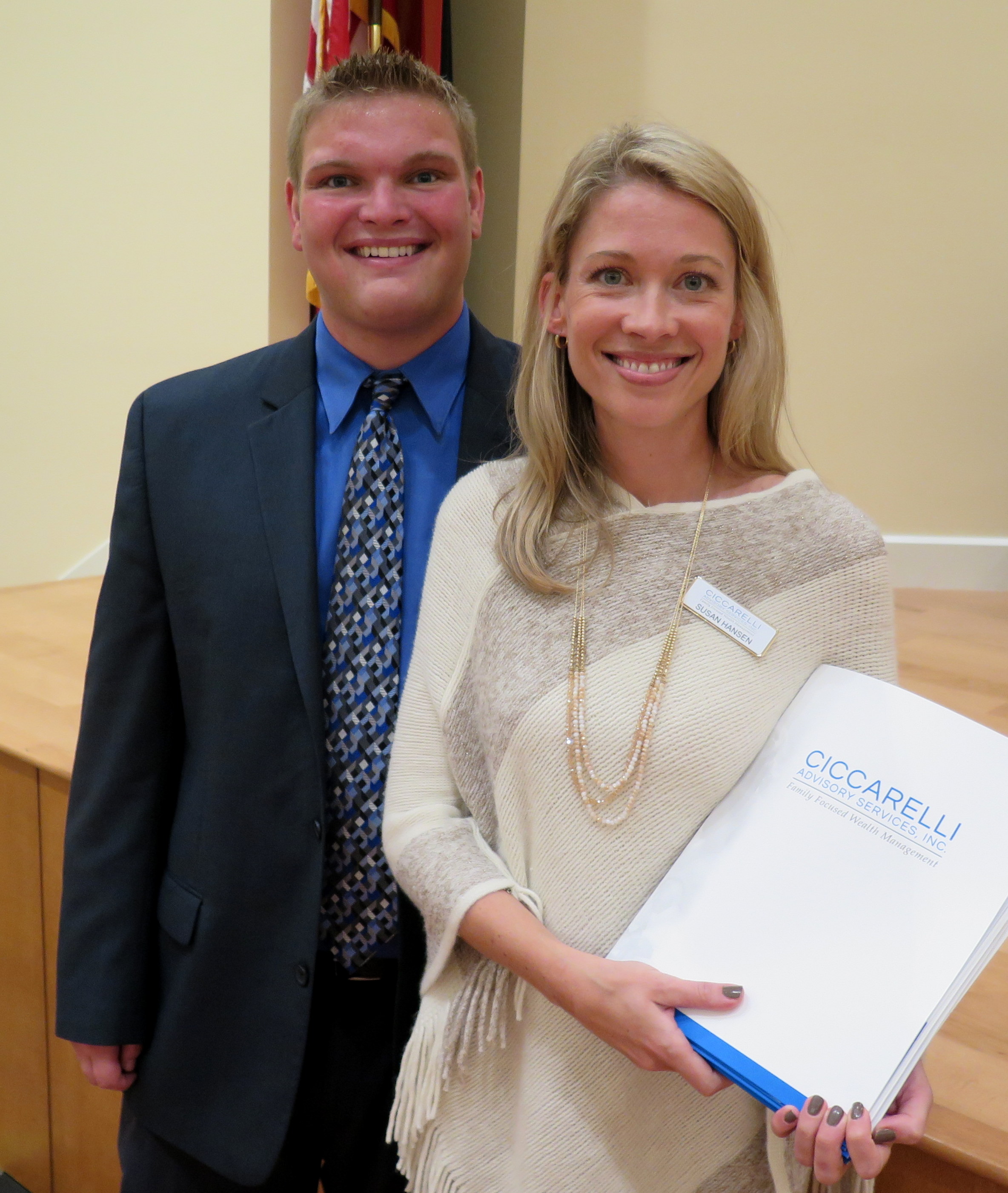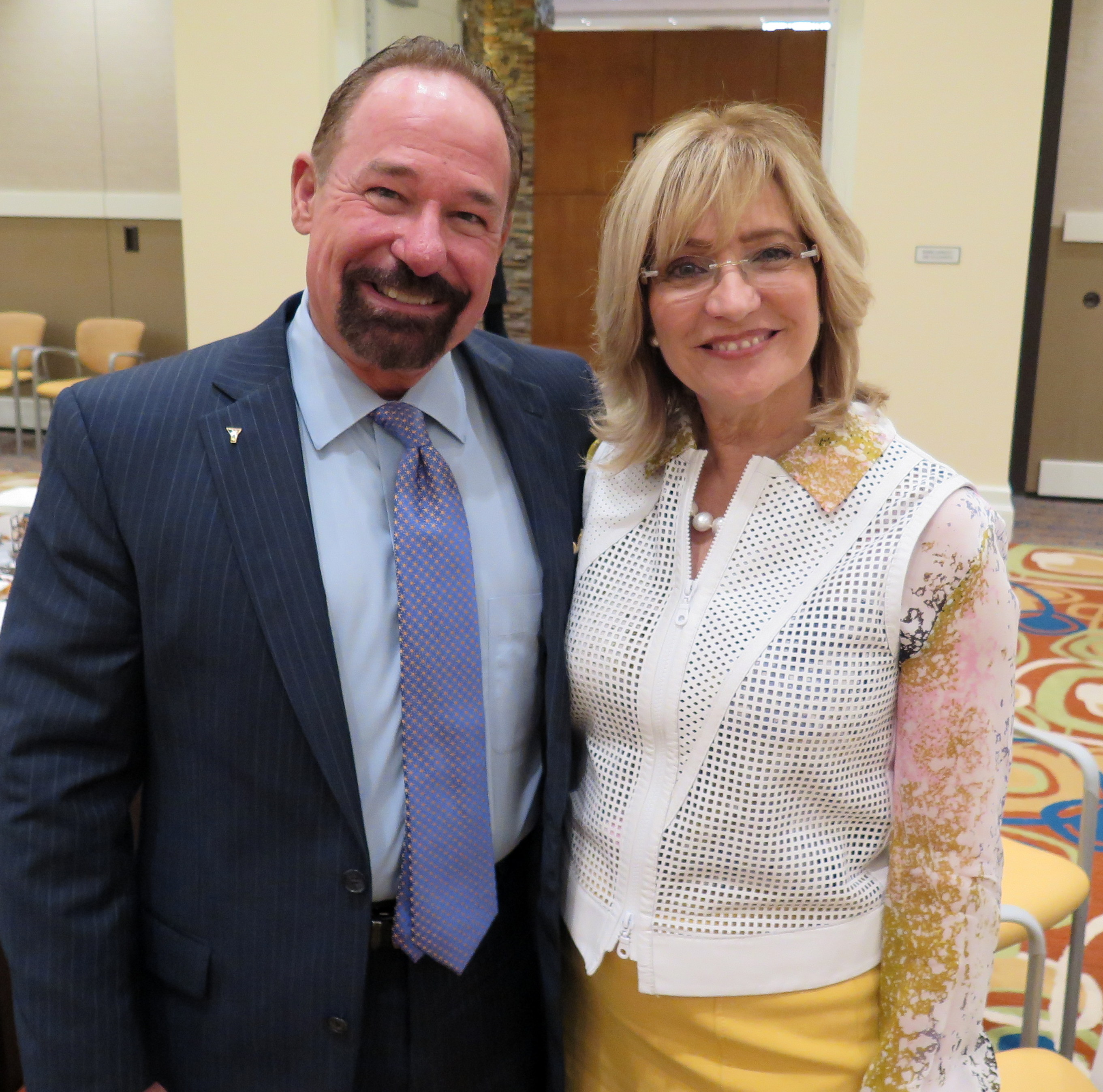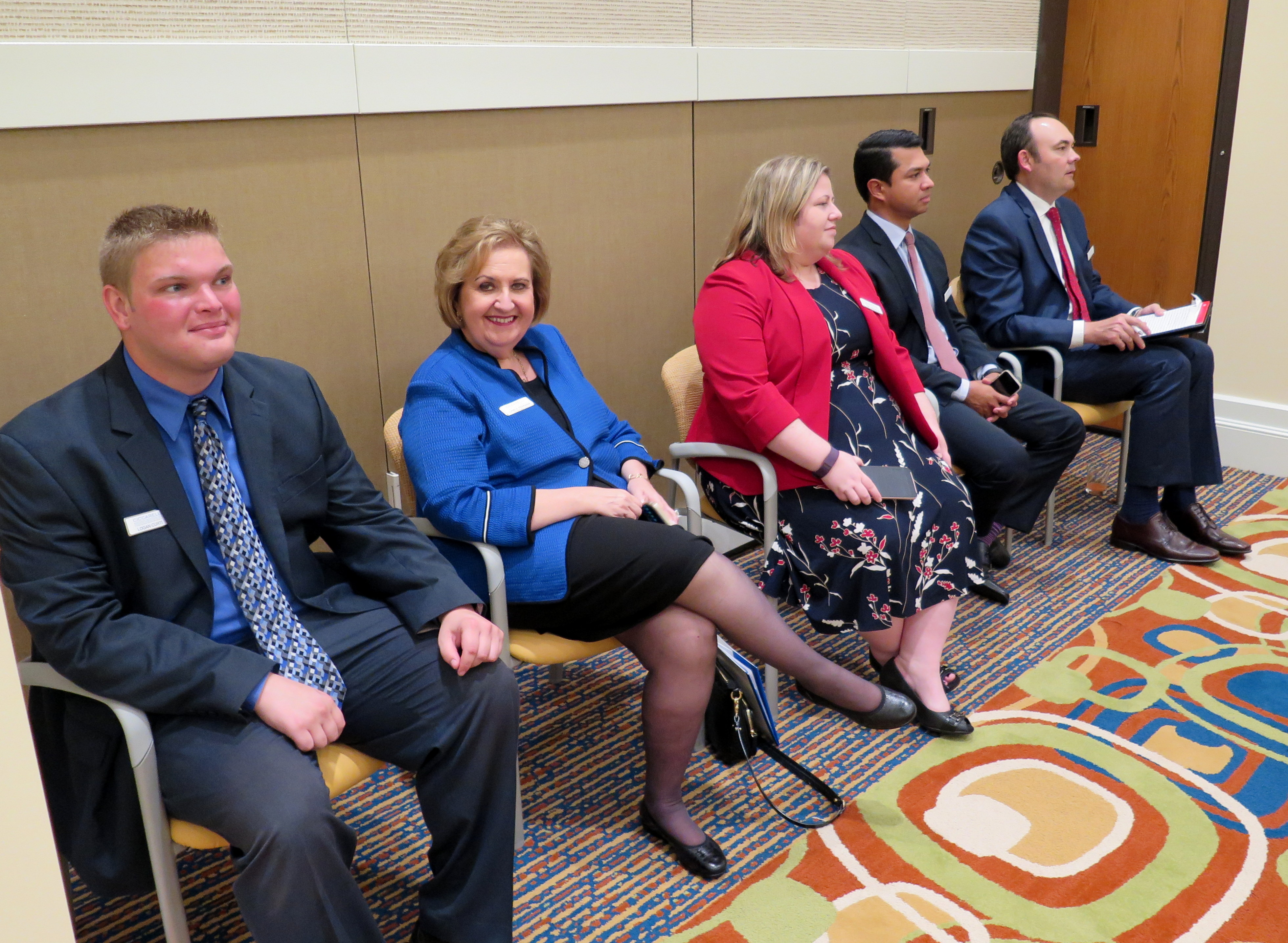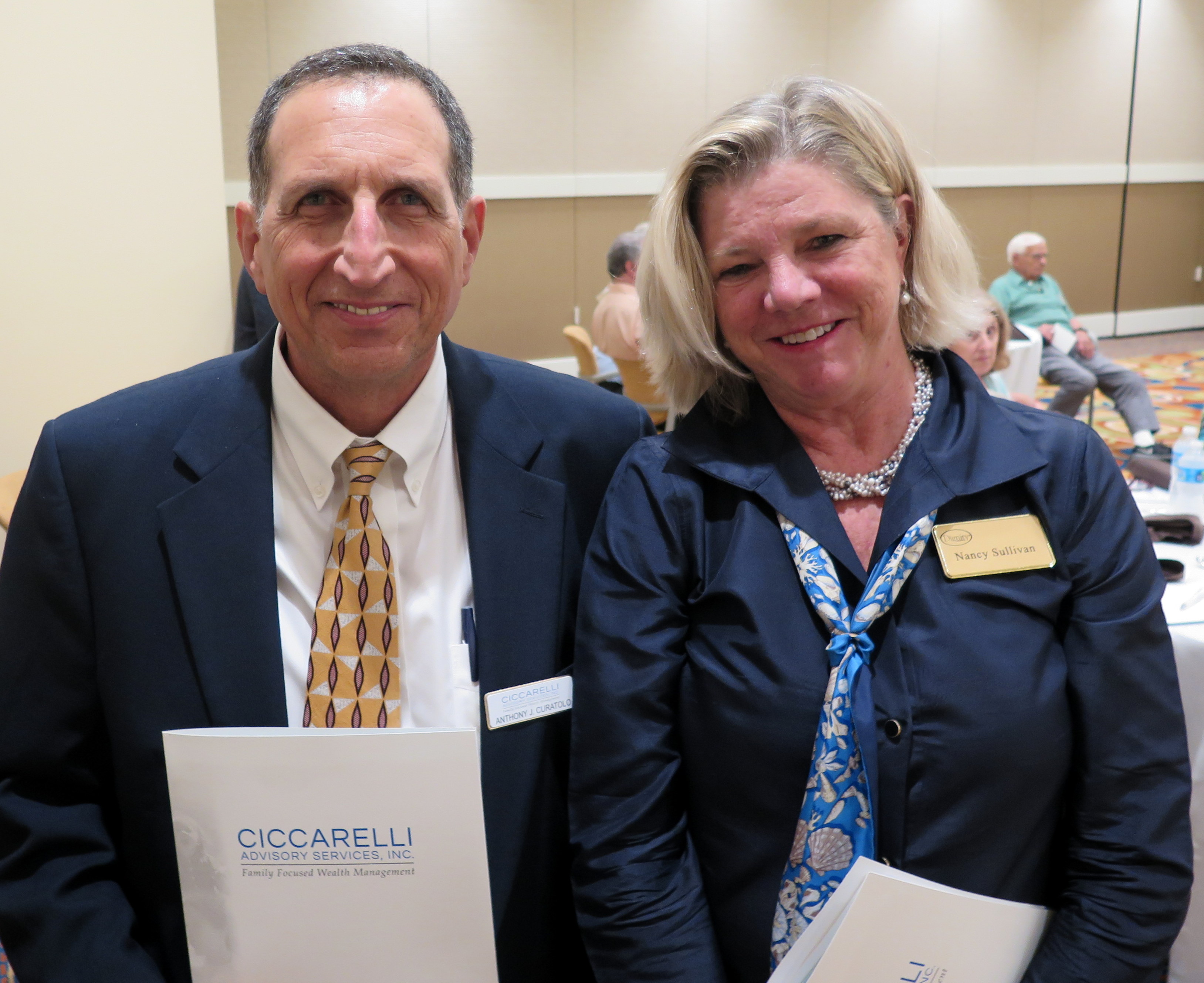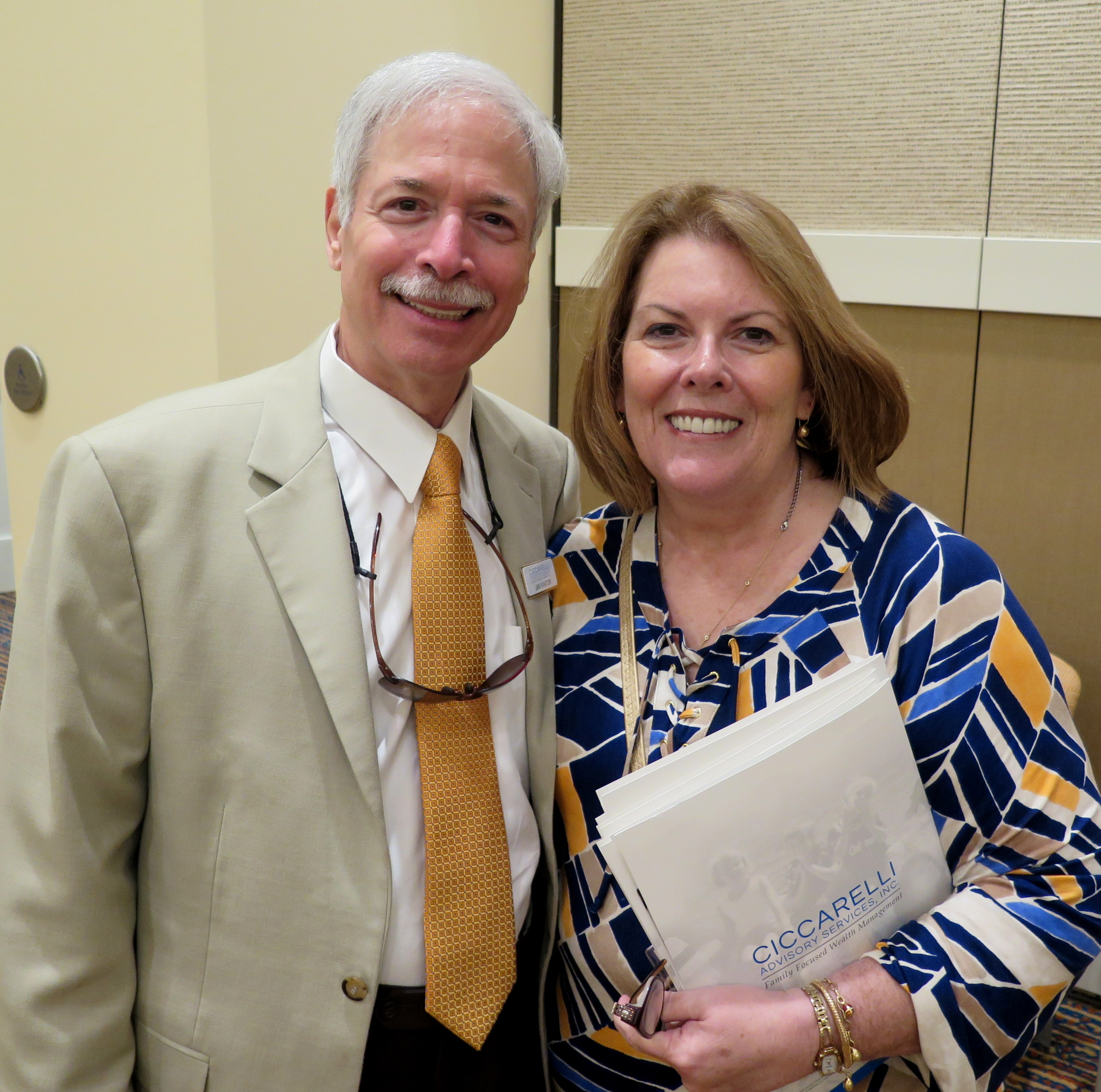CAS News
Naples Estate Planning Seminar
On January 20, our panel of legal and financial professionals shared their insight on a variety of crucial estate planning topics:
–Beneficiary designations
–Digital assets
–Trust protector provisions and flexibility
–Common estate planning time bombs
–The estate planning outlook under the Trump administration.
The Golden Years – Your Ideal Retirement
 Jill Ciccarelli Rapps | Life in Naples Magazine | February 2017
Jill Ciccarelli Rapps | Life in Naples Magazine | February 2017
My father always said that your “golden years” are between ages 50-80. This is when you are in good health, have gained wisdom and hopefully have gathered enough assets to support your lifestyle. It is an exciting time in your life. If you plan well, you will finally have the time to do everything you’ve always wanted: exploring the world through travel, spending time with your family, or discovering a new favorite hobby.
In order to bring your retirement dreams to fruition, you need to create a financial strategy that will support your desired lifestyle. By preparing and executing a strategy that reflects your wishes, you will likely find the golden years of your retirement to be a liberating and enjoyable experience.
Determine Your Goals
In order to understand your income needs during retirement, it’s imperative to spend some time determining how you want your golden years to look. We take our clients through a special process of defining and clarifying what is most important to them by allowing them to brainstorm ideas on a blank canvas.
As an example, you may want to relocate another climate, or move closer to your family. Do you envision yourself travelling and exploring exotic places around the world? Or would you rather just relax – maybe rebuild a classic car or learn how to paint? Your retirement goals serve as the framework for your savings plan, and will be instrumental in helping you to go confidently in the direction of your dreams.
Start Early
The key to living to the fullest in your golden years is to start planning early. Understanding where you are today and where you want to be in your golden years; making necessary adjustments today can make all the difference tomorrow. When you are 3-5 years away from retirement, you should begin thinking about creative ways to create the income you will need and consider how best to reduce taxable income. As with everything that is worthwhile, this takes time. The more time you have to plan, the better!

Think Long Term
When you imagine your retirement, you likely think about the early years – when you are in good health and medical complications don’t impede on your livelihood. Though our health tends to decline as we age, you shouldn’t hesitate to make plans well into your later years. In fact, the number one area that retirees tend to underprepare for is health care costs. Setting retirement goals that extend well into your 80s and 90s can inspire you to continue leading an active, purpose-driven lifestyle – which, in turn, often leads to increased longevity and life satisfaction.
Partner with a Financial Expert
The best way to enhance your retirement experience is through a partnership with a financial expert. Given all the complex variables that exist in today’s retirement landscape – inflation, rising insurance and health care costs, changing tax laws, potential fluctuations in your future income, and family dynamics – the need for expert financial advice is greater than ever before.
Start with a Clean Slate
Retirement is the ideal time to re-evaluate your overall attitude towards money. Consider how your money can serve as a tool for achieving your highest values in life. By retirement age, you have probably collected all the physical possessions you need, and you likely have plenty of free time to pursue new endeavors in your life. Based on that, you may find it to be advantageous to start thinking about money in terms of the experiences you can afford.
Whether you are saving for a grandchild’s college tuition or supporting a charitable cause that is close to your heart, a fundamental shift in how you view money can empower you to achieve these aspirations.
Through careful planning and consistent motivation, you will have a better opportunity to position yourself to meet all of your retirement goals. In the end, a solid financial plan and a winning team of financial professionals will serve as your GPS – guiding you towards happiness and personal fulfillment throughout your golden years.
Four Keys to Becoming an Effective Caregiver
 Jill Ciccarelli Rapps | éBella Magazine | December 2016
Jill Ciccarelli Rapps | éBella Magazine | December 2016
Sooner than later, you may find yourself in a position where you need to take care of your spouse, parents, grandparents, or another family member. Becoming a caregiver for your ailing family member is a major commitment that can be emotionally and mentally draining.
You can ease the stress of being a caregiver through preparation and balance. By practicing the four keys to effective caregiving, you empower yourself to handle your caregiver responsibilities in a way that meets both of your needs.
Understand Your Financial Resources
Financial preparedness is a vital aspect of caregiving. The cost of health care is astronomical and continues to rise at a steady rate. By failing to account for health care expenses, you may find yourself in a predicament where you and your loved ones can no longer maintain the lifestyle you all currently enjoy.
 When you become the primary caregiver for your loved one, you need to develop a nuanced understanding of your family’s financial resources. Creating a detailed budget is the most effective way to fully evaluate your situation. Review your important financial documents – tax returns, estate planning documents, bank statements, and insurance policies – and record monthly expenses.
When you become the primary caregiver for your loved one, you need to develop a nuanced understanding of your family’s financial resources. Creating a detailed budget is the most effective way to fully evaluate your situation. Review your important financial documents – tax returns, estate planning documents, bank statements, and insurance policies – and record monthly expenses.
You should discuss your budget with a financial advisor. Your advisor can help you consolidate and simplify financial information, recommend updates to your health care strategy and estate plan, and conduct a conversation about how your loved one would like to address health care decisions. By examining the “big picture” with your advisor, you position yourself to make financially prudent health care decisions.
Get Organized
As a caregiver, you will have to juggle a plethora of responsibilities – caring for your loved one’s basic needs, managing their medication and therapy schedules, and handling household chores. Getting organized is the key to proactively addressing your obligations and minimizing stress.
There are two simple ways to combat stress through organization. First, consider what you do best. Focus on these tasks and “give away the rest”. By hiring people to assist you, you can capitalize on your strengths and let the professionals handle tasks that you find to be difficult.
Secondly, create a system for tracking and documenting your loved one’s health-related information. Your organizational system should account for their day-to-day needs (medication, diet and exercise requirements, etc.), appointments, and health care expenses. As a result of keeping orderly records, you can facilitate open communication with medical professionals and your family.
Spend Quality Time Together
The caregiver-patient dynamic can strain your relationship with your family member – especially if your interactions are exclusively related to caregiving. To prevent this friction, make sure to schedule quality time together.
Each day, dedicate a few hours to enjoying each other’s company – watching TV, playing cards, or engaging in a lighthearted conversation. Spending quality time together will foster healthy communication and affection, and will help you to maintain and develop your relationship.

Take Care of Yourself
When you dedicate your time and energy to ensuring that your loved one’s needs are met, you may find it difficult to focus on your personal wellness. Many caregivers feel guilty when they think about themselves instead of paying attention to their ill family member. However, you should not allow guilt or other emotions to prevent you from satisfying your needs.
Your ability to effectively serve as a caregiver is compromised when you don’t take care of yourself. Make sure that you are eating right, exercising, and meeting your wellness needs. Take care of your own financial security and avoid making sacrifices that could negatively impact your future. Feel free to take a break occasionally.
If you feel overwhelmed, do not hesitate to ask for help. Capitalize on the resources that exist in our community – other family members, friends, community health care services or home care professionals. A little assistance can provide you with the stamina you need to continue providing exceptional care.
A financial planner can serve as a valuable asset for caregivers. Your advisor can guide you in developing an organized financial plan, empowering you to become an effective caregiver and achieve balance in your life.
16 Things to Do Before You Die
 By Steven Merkel, CFP®, ChFC® | Investopedia.com
By Steven Merkel, CFP®, ChFC® | Investopedia.com
While many of us like to think that we’re immortal, the old joke is that only two things in life are certain: death and taxes.
Not only is it essential for you to have a plan in place in the unlikely event of your death, but you must also implement your plan and make sure your loved ones understand your wishes. As Benjamin Franklin’s famous quote goes, “By failing to prepare, you are preparing to fail.”
If you’ve procrastinated on your estate plan, this article will help you move in the right direction.
- Do a Physical Items Inventory
To start things out, go through the inside and outside of your home and make a list of all items worth $100 or more. Examples include the home itself, television sets, jewelry, collectibles, vehicles, guns, computers/laptops, lawn mower, power tools and so on.
- Follow with a Non-Physical Items Inventory
Next, start adding up your non-physical assets. These include things you own on paper or other entitlements that are predicated on your death. Items listed here would include: brokerage accounts, 401k plans, IRA assets, bank accounts, life insurance policies, and ALL other existing insurance policies such as long-term care, homeowners, auto, disability, health and so on.
- Assemble a Credit Cards & Debts List
Here you’ll make a separate list for open credit cards and other debts. This should include everything such as auto loans, existing mortgages, home equity lines of credit, open credit cards with and without balances, and any other debts you might owe. A good practice is to run a free credit report at least once a year. It will identify any credit cards you may have forgotten you have.
- Make an Organization & Charitable Memberships List
If you belong to certain organizations such as the AARP, The American Legion, Veteran’s associations, AAA Auto Club, College Alumni, etc., you should make a list of these. Include any other charitable organizations that you proudly support or make donations to. In some cases, several of these organizations have accidental life insurance benefits (at no cost) on their members and your beneficiaries may be eligible. It’s also a good idea to let your beneficiaries know which charitable organizations are close to your heart.
- Send a Copy of Your Assets List to Your Estate Administrator
When your lists are completed, you should date and sign them and make at least three copies. The original should be given to your estate administrator (we’ll talk about him or her later in the article). The second copy should be given to your spouse (if you’re married) and placed in a safe deposit box. Keep the last copy for yourself in a safe place.
- Review IRA, 401(k) and Other Retirement Accounts
Accounts and policies in which you list beneficiary designations pass via “contract” to that person or entity listed at your death. No matter how you list these accounts/policies in your will or trust, it doesn’t matter because the beneficiary listing will take precedence. Review each of these accounts to make sure the beneficiaries are listed exactly as you like.

- Update Your Life Insurance & Annuities
Life insurance and annuities will pass by contract as well, so it’s equally important that you ensure that your beneficiaries are listed correctly on each of these accounts.
- Assign TOD Designations
TOD stands for transfer on death. Many accounts such as bank savings, CD accounts and individual brokerage accounts are unnecessarily probated every day. Probate is an avoidable court process through which assets are distributed per court instruction, which can be costly. Many of the accounts listed above can be set up with a transfer-on-death feature to avoid the probate process.
- Select a Responsible Estate Administrator
Your estate administrator will be responsible for following the rules of your will in the event of your death. It is important that you select an individual who is responsible and in a good mental state to make decisions. Don’t immediately assume that your spouse is the best choice. Think about all qualified individuals and how emotions related to your death will affect this person’s decision-making ability.
- Create a Will
Everyone over the age of 18 should have a will. It is the rulebook for distribution of your assets and it could prevent havoc among your heirs. Wills are fairly inexpensive estate planning documents to draft. Most attorneys can help you with this for less than $1,000. If that’s outside your budget, there are several good will-making software packages available online for home computer use. Make sure that you always sign and date your will, have two witnesses sign it and obtain a notarization on the final draft.
- Review & Update Your Documents
Review your will for updates at least once every two years and after any major life-changing events (marriage, divorce, birth of child, and so on). Life is constantly changing and your inventory list is likely to change from year to year too.
- Send Copies of Your Will to Your Estate Administrator
Once your will is finalized, signed, witnessed and notarized, you’ll want to make sure that your estate administrator gets a copy. You should also keep a copy in a safe-deposit box and in a safe place at home.
- Visit a Financial Planner or an Estate Attorney
While you may think that you’ve covered all avenues, it’s always a good idea to have a full investment and insurance plan done at least once every five years.
As you get older, life throws new curveballs at you, such as figuring out whether you need long-term care insurance and protecting your estate from a large tax bill or lengthy court processes. Tips like having an emergency medical contact card in your purse or wallet are little things many people never think of that an expert can help you learn.
- Initiate Important Estate-Plan Documents
Procrastination is the biggest enemy to estate planning. While none of us likes to think about dying, the fact of the matter is that improper or no planning can lead to family disputes, assets going into the wrong hands, long court litigations and huge amounts of dollars in federal tax.
At minimum, you should create a will, power of attorney, healthcare surrogate, and living will – and assign guardianship for your kids and pets. If you’re married, each spouse should create a separate will, with plans for the surviving spouse. Also make sure that all the concerned individuals have copies of these documents.
- Simplify Your Finances
If you’ve changed jobs over the years, it’s quite likely that you have several different 401(k)-type retirement plans still open with past employers or maybe even several different IRA accounts. While this normally won’t create a big problem while you’re alive (except lots of additional paperwork and account management), you may want to consider consolidating these accounts into one individual IRA account to take advantage of better investment choices, lower costs, a larger selection of investments, more control and less paperwork/easier management when assets are consolidated.
- Take Advantage of College Funding Accounts
The 529 plan is a unique tax-advantaged investment account for college savings. In addition, most universities do not consider 529 plans in the financial aid/scholarship calculation if a grandparent is listed as the custodian. The really nice feature is that growth and withdrawals from the account (if used for “qualified” education expenses) are tax-free. If you have grandchildren and the assets to do it, consider opening a plan for each grandchild.
The Bottom Line
Now you have the knowledge you need to get a good jump-start on reviewing your overall financial and estate picture; the rest is up to you. While you’re sitting around the house watching your favorite sports team or television show, pull out a tablet or laptop and start making your lists.
You’ll be surprised how much stuff you’ve accumulated over the years. You’ll also find that your inventory and debts lists will come in handy for other tasks such as homeowners insurance and getting a firm grip on your expenses.
Content was created by the author for a third-party website. Acknowledgement to Investopedia.com for the use of their article.
2016 in Review – An Economic Update
You know you’re deep into a longstanding bull market when you see things like average pedestrians keeping one eye on the market tickers outside of brokerage houses to see when the Dow Jones Industrial Average has finally breached the 20,000 mark. Who would have imagined record market highs at this point last year, when the indices ended the year in negative territory? Or when 2016 got off to such a rocky start, tumbling 10% in the first two weeks—the worst start to a year since 1930?
The markets eventually bottomed in mid-February and began a long, slow recovery, turning positive by the end of March, suffering a setback when the U.K. decided to leave the Eurozone and endured another hard bump right after the elections. In the end, we were disappointed; the Dow finished at 19,762.60 for the year—by the bull market has continued for another year.
 This was the second year in a row that the final quarter provided investors with solid gains. The Wilshire 5000–the broadest measure of U.S. stocks—was up 4.54% in the fourth quarter of 2016, ending the year up 13.37%. The comparable Russell 3000 index gained 4.21% in the final quarter, to finish up 12.74% for the year.
This was the second year in a row that the final quarter provided investors with solid gains. The Wilshire 5000–the broadest measure of U.S. stocks—was up 4.54% in the fourth quarter of 2016, ending the year up 13.37%. The comparable Russell 3000 index gained 4.21% in the final quarter, to finish up 12.74% for the year.
Large cap stocks were up as well. The Wilshire U.S. Large Cap index gained 4.14% in the fourth quarter, and finished the year up 12.49%. The Russell 1000 large-cap index closed with a 3.83% fourth quarter performance, and finished the year up 12.05%, while the widely-quoted S&P 500 index of large company stocks was up 3.25% in the fourth quarter, finishing up 9.54% for calendar 2016.
The Wilshire U.S. Mid-Cap index gained 5.31% in the final quarter, finishing the year with a gain of 17.22%. The Russell Midcap Index gained 3.21% in the fourth quarter, and was up 13.80% in calendar 2016.
This was a year to remember for investors in small company stocks. As measured by the Wilshire U.S. Small-Cap index, investors posted an 8.30% gain over the last three months of the year, for a total return of 22.41% over the entire 12 months. The comparable Russell 2000 Small-Cap Index finished the year up 21.31%, while the technology-heavy Nasdaq Composite Index rose 1.34% in the fourth quarter, to finish the year up 7.50%.
International investments contributed a slight decline to overall portfolio returns. The broad-based EAFE index of companies in developed foreign economies lost 1.04% in the fourth quarter of the year, finishing the year down 1.88% in dollar terms. In aggregate, European stocks lost 3.39% for the year, while EAFE’s Far East Index gained just 0.14%. Emerging markets stocks of less developed countries, as represented by the EAFE EM index, gained 8.58% for the year.
Looking over the other investment categories, real estate investments, as measured by the Wilshire U.S. REIT index, lost 2.28% during the year’s final quarter, but managed to finish up 7.24% for calendar 2016.
Last year, investors were wondering why they owned commodities in their portfolios, when their statements showed that the index delivered a whopping 32.86% loss. This year, they may be wondering why they weren’t more committed to the asset class, as the S&P GSCI index gained 27.77%, fueled in part by a 45.03% rise in the S&P crude oil index. Gold prices shot up 8.63% for the year and silver gained 15.84%.
In the bond markets, it’s possible that the decades-long bull market—which basically means declining interest rates—has ended, and the fixed-income world is experiencing rate rises. But despite the nudge by the Federal Reserve Board, the moves have not exactly been dramatic. Over the past year, rates on 10-year Treasury bonds have risen from 2.25% to 2.44%, while 30-year government bond yields have risen from 3.00% to 3.07%. According to Barclay’s Bank indices, U.S. liquid corporate bonds with a 1-5 year maturity have seen yields rise incrementally from 2.4% to 2.8% on average.
As always, there were many unpredictable anomalies in the investment world. In the international markets, anyone lucky enough to have speculated on the Brazilian Bovespa index—comparable to the U.S. S&P 500—would have reaped a gain of 68.9% this year, despite all the headline drama around the Zika virus and political uncertainties that were reported on during the Olympic games. Russian stocks were up 51% for the year, despite the recent sanctions from the U.S. government and the lingering international sanctions related to the invasion of the Crimean peninsula.
What’s going to happen in 2017? Short-term market traders seem to be expecting a robust economic stimulus combined with lower taxes and deregulatory policies that would boost the short-term profits of American corporations. But it is helpful to remember that we are entering the ninth year of economic expansion, making this the fourth longest since 1900. In addition, growth has not exactly been robust; the U.S. GDP has averaged just 2.1% yearly increases since the Great Recession, making this the most sluggish of all post-World War II expansions.
Slow but steady has not been a terrible formula for workers or stock investors. The unemployment rate has slowly ticked down from a post-recession peak of 10% to less than 5% currently. U.S. stock indices are posting record highs with double-digit gains, and that Dow 20,000 level, while essentially meaningless, is still catching a lot of attention.
It’s clear that the new President-elect wants to accelerate America’s economic growth, but the policy prescription has not always been clear. Will we rip up longstanding trade agreements, cut back on immigration quotas and deport millions of workers who crossed the border without a visa? Will there be a wall built between the U.S. and Mexico? Will the government pay for huge infrastructure projects, at the same time reducing taxes and thus raising the national debt? Will Congress raise the debt ceiling without protest if that happens? Will the Fed raise rates more aggressively in the coming year, or cooperate with the President-elect in his efforts to drive the economy into a faster lane?
At the same time, there are many unknowns around the globe. China’s economic growth has stalled for the second consecutive year, and you will soon be reading about a banking crisis in Italy that could force the country to leave the Eurozone—potentially a much bigger blow to European economic unity than Brexit or a still-possible Greek exit. Russian hackers may have ushered in an era of unfettered global intrusions into our Internet infrastructure, and there will surely be a continuation of ISIS-sponsored terrorism in Europe and elsewhere.
Every year of this longstanding bull market, we have to look over our shoulders and wonder when and how it will end. With the January downturn and so much uncertainty at this time last year, nobody could have predicted double-digit returns on U.S. stocks at year-end. Next year could bring more of the same, or it could fulfill the dire predictions many have made during the election cycle, including both Democrats and Republicans who believe the country is in worse shape than the numbers would indicate.
What we have learned over the past few years is that the markets have a way of surprising us, and that trying to time the market, and get out in anticipation of a downturn, is a loser’s game. At the county fair, when we get on the roller coaster, we don’t bail out and jump over the side at some scary point on the track; we hang on for the ride. The history of the markets has been a general upward trend that benefits long-term investors, and looking out over the long-term, that—and a few hard bumps along the way–is probably the best outcome to expect.
Sources:
Wilshire index data: http://www.wilshire.com/Indexes/calculator/
Russell index data: http://www.russell.com/indexes/data/daily_total_returns_us.asp
S&P index data: http://www.standardandpoors.com/indices/sp-500/en/us/?indexId=spusa-500-usduf–p-us-l–
Nasdaq index data:
http://quotes.morningstar.com/indexquote/quote.html?t=COMP
http://www.nasdaq.com/markets/indices/nasdaq-total-returns.aspx
International indices: https://www.msci.com/end-of-day-data-search
Commodities index data: http://us.spindices.com/index-family/commodities/sp-gsci
Treasury market rates: http://www.bloomberg.com/markets/rates-bonds/government-bonds/us/
Aggregate corporate bond rates:
https://index.barcap.com/Benchmark_Indices/Aggregate/Bond_Indices
Aggregate corporate bond rates: http://www.bloomberg.com/markets/rates-bonds/corporate-bonds/
Muni rates: https://indices.barcap.com/show?url=Benchmark_Indices/Aggregate/Bond_Indices
http://www.wsj.com/articles/chinas-stock-market-still-a-draw-after-tumultuous-year-1451303164
http://www.theworldin.com/article/10632/unsettling-year-markets
Southwest Florida Out and About
Check out Kim and Paul’s interview with Southwest Florida Out and About!
Our segment airs on ABC at 11:30 a.m. on Sunday, January 15.
Protecting Your Family’s Assets
 Jill Ciccarelli Rapps | Life in Naples Magazine | January 2017
Jill Ciccarelli Rapps | Life in Naples Magazine | January 2017
Estate planning can be a difficult subject to discuss. Many people prefer to avoid broaching this topic, as it can be uncomfortable to think about your own mortality.
That being said, having an in-depth conversation about estate planning is the key to protecting your assets and providing a bright future for your family. By partnering with a financial advisor to plan your legacy, you can prevent common estate planning pitfalls and promote the financial well-being of your spouse, children and future generations.
The following tips will help you establish a plan that reflects your desires and vision for the future.

Create an Inventory of Assets
The first step in estate planning is creating a comprehensive inventory of your assets – including property, business holdings, savings, and annuities. In your inventory, be sure to include all of your account numbers, dated statements and an explanation of how each asset is owned. By doing so, you will find it much easy to keep your records up-to-date when your estate plan is executed.
With this foundation in place, you can develop a succession strategy in accordance with your wishes. To make this vision a reality, it is crucial to understand how the estate laws and taxes will impact your assets. A financial expert can help you navigate the red tape and capitalize on opportunities for tax relief.
Evaluate Life Insurance Coverage
Life insurance can be a critical component of your estate plan, especially if your family members rely on you for financial support. Life insurance provides you with the liquidity you need to protect your business holdings and make sure that your heirs are not forced to sell assets. Life insurance also serves as a great method for passing tax-free inheritance to your loved ones.
To take full advantage of life insurance benefits, you need to understand the types of coverage that are available. You should evaluate the differences between life insurance plans (i.e. term versus whole life coverage) and determine which policy will best fulfill your needs.
To effectively safeguard your assets, you should review all of your existing policies with your financial advisor every 2-3 years, or whenever you experience a major transition in your life. It is also crucial to make sure that your beneficiary designations are up-to-date.
Consider a Living Trust
A living trust can also play a key role in preserving your assets. Living trusts can help you to bypass probate, and reduce the costs and hassle associated with passing your inheritance to your family. Living trusts are especially advantageous if you have minor children, property in multiple states, or a large estate that will be subject to estate tax burdens (i.e. estates with assets totaling $5.45 million or more).
Draft a Will
Once you have a clear picture of your assets and a strategy for managing your inheritance, you will need to create a will. In your will, you designate the placement of your assets, name beneficiaries, and establish the executor of your estate. Your will serves as the cornerstone of your estate plan; in fact, your loved ones may receive little to no inheritance if you fail to draft a will.
While there are many online resources to help you draft a will, these templates may not cover all of your estate planning needs. The best approach for creating your will is to collaborate with an attorney and a financial advisor. A team of professionals can assist you in alleviating any complications you may experience when your will is executed.
Gather Official Documents
Once you have planned your estate, you will need to gather your official documents, including:
- Your will
- Powers of attorney and advanced medical directives
- Life insurance policies
- Inventory of assets (including bank statements, property titles and deeds, safety deposit boxes, stocks and savings bonds)
- Beneficiary forms for life insurance and retirement accounts
- Living trusts
- A list of important contacts (your attorney, financial planner, trustees and executor)
Once you complied your official documents, find a secure location to store your paperwork that is easily accessible to your family.
In order to preserve your legacy for future generations, you need a detailed estate plan that reflects your wishes. Whether you have $1 million in assets or an estate of $10 million or more, establishing a partnership with a financial advisor is the best decision you can make. Now is the time to organize your estate plan, facilitate a winning strategy and provide for your family’s future!
Simplify and Organize Your Financial Life
 Jill Ciccarelli Rapps | Life in Naples Magazine | December 2016
Jill Ciccarelli Rapps | Life in Naples Magazine | December 2016
Managing your money can be a headache, especially if you make financial decisions on the fly. A haphazard approach to overseeing your finances can damage your financial wellness, leading to unnecessary costs and wasteful spending.
As we transition into 2017, many of us are pursuing New Year’s resolutions. As you consider ways to improve your quality of life during the new year, we encourage you to follow these five easy steps for simplifying and organizing your financial life.
By doing so, you put yourself in a position where you can proactively control your money – empowering you to achieve financial success.
Set financial goals
Articulating your goals will help you to prioritize your spending. Identify the biggest financial undertaking you face – for instance, paying off your mortgage, purchasing a second home, saving for your dream vacation, putting your grandchildren through college or preparing for retirement – and write them down where you can visit them often.
Draw up a spending budget
Review all of your income and earnings statements, and understand how much revenue you will have for the month. Then, go through your expenditures and prioritize your future spending. Refer to your budget at least once per month to ensure that you adjust for unexpected income or expenses.
Once you develop a clear picture of your cash flow, you can create a budget that accurately reflects your lifestyle and empowers you to realize your goals.
Create a filing system
Maintaining files of your important documents is instrumental to organizing your life. The key to organization is finding a system that works for you. By doing so, you will find it much less cumbersome to keep up on your financial files.
 For instance, many people prefer working with physical files and paper documents. If this is your preference, I recommend keeping a large basket on your desk for dropping receipts, statements and tax information. Twice a year, you should dedicate time to sorting through these documents. Often times, you will find that the paperwork you thought was important at the time can actually be shredded. After your biannual sorting session, you should retain all of your crucial information in categorized manila files.
For instance, many people prefer working with physical files and paper documents. If this is your preference, I recommend keeping a large basket on your desk for dropping receipts, statements and tax information. Twice a year, you should dedicate time to sorting through these documents. Often times, you will find that the paperwork you thought was important at the time can actually be shredded. After your biannual sorting session, you should retain all of your crucial information in categorized manila files.
Finally, dedicate a folder to housing your official documents – including your estate planning files, social security card, savings bonds and insurance policies. All of your files should be saved in a secure location, such as a safe at home, deposit box at the bank, or an online vault. These files should be easily accessible for you, your trustee and your family.
Consider using financial software
For those of you who are more technologically inclined, financial software can serve as a valuable resource for managing your money.
Many of these programs feature built-in templates to help you devise your monthly budgets. Some financial software will also provide you with detailed analytics about your spending habits, enhancing your ability to monitor and control expenses. There are even applications that will scan your receipts and important documents, creating digital archives for your financial information. If you choose to work with financial software, make sure to protect your information from unauthorized access by using encrypted software and creating strong passwords.
Your financial advisor can help you input and consolidate all your financial information in the program, further simplifying the process of managing your money.
Set up direct deposits and withdrawals
Arranging automatic deposits and withdrawals saves you time and effort while ensuring that your bills are paid on time. All regular income should be directly deposited into your bank account; most banks will allow you to split your deposits between different accounts, so you may allocate your deposits to various goals you have identified.
You should also set up any regular monthly expenses – rent, car payments and utilities – to be automatically withdrawn. Although you may prefer paper bills, setting up automatic payments will be helpful in the event that someone else needs to pay your bills (for instance, if you were to become incapacitated).
While these tips will guide you towards a simplified and organized financial life, you should also consider meeting with a financial planner. Financial planners may help you achieve your financial goals by designing your monthly budget, consolidating your key documents, and generating creative solutions to maximize your money.
Federal Reserve Interest Rate Hike
 Was anybody surprised that the Federal Reserve Board decided to raise its benchmark interest rate last week?
Was anybody surprised that the Federal Reserve Board decided to raise its benchmark interest rate last week?
The U.S. economy is humming along, the stock market is booming and the unemployment rate has fallen faster than anybody expected. The incoming administration has promised lower taxes and a stimulatory $550 billion infrastructure investment. The question on the minds of most observers is: what were they waiting for?
The rate rise is extremely conservative: up 0.25%, to a range from 0.50% to 0.75% – which, as you can see from the chart, is just a blip compared to where the Fed had its rates ten years ago.

The bigger news is the announced intention to raise rates three times next year and to move rates to a “normal” 3% by the end of 2019—which is faster than some anticipated, although still somewhat conservative. Whether any of that will happen is unknown; after all, in December 2015, the Fed was telegraphing two and possibly three rate adjustments in 2016, before backing off until now.
The rise in rates is good news for those who believe that the Fed has intruded on normal market forces by suppressing interest rates much longer than could be considered prudent, and even better news for people who are bullish about the U.S. economy.
The Fed may have been the last remaining skeptic that the U.S. was out of the danger zone of falling back into recession; indeed, its announcement acknowledged the sustainable growth in economic activity and low unemployment as positive signs for the future.
However, bond investors might be less pleased, as higher bond rates mean that existing bonds lose value. The recent rise in bond rates at least hints that the long bull market in fixed-rate securities—that is, declining yields on bonds—may finally be over.
For stocks, the impact is more nuanced. Bonds and other interest-bearing securities compete with stocks in the sense that they offer stable—if historically lower—returns on your investment. As interest rates rise, the see-saw between whether you prefer stability or future growth tips a bit, and some stock investors move some of their investments into bonds, reducing demand for stocks and potentially lowering future returns.
None of that, alas, can be predicted in advance, and the fact that the Fed has finally admitted that the economy is capable of surviving higher rates should be good news for people who are investing in the companies that make up the economy.
The Bottom Line
There is no reason to change your investment plan as a result of a 0.25% change in a rate that the Fed charges banks when they borrow funds overnight. There is always too much uncertainty about the future to make accurate predictions, and today, with the incoming administration, the tax proposals, the fiscal stimulation, and the real and proposed shifts in interest rates, the uncertainty level may be higher than usual.
Holiday Cheer to End the Year!
Wishing you and your family
a wonderful holiday season
and a prosperous new year!



